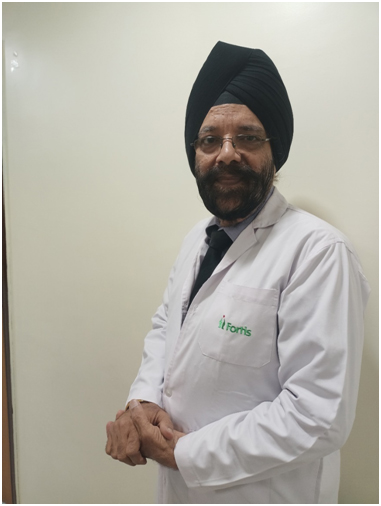'A variety of common workers' diseases appear to be caused by prolonged, violent, and irregular motions and prolonged postures'
We spoke to Dr. Manjeet Singh Arora, Occupational Health Physician, Consultant Fortis Hospital, Mumbai & National Trainer - First Aid / CPR / Safety. He is a competent physician from the premier institute Grant Medical College, Sir J.J. Group of hospitals, Mumbai. Apart from his clinical practice for 35 years he is an exceptional trainer on First-Aid/CPR/Handling of emergencies, Safety and Behaviour based Safety in an industry. He brings with him 24 years of experience in Occupational Health having worked with in a couple of various industries including many MNCs like Hoechst, Burroughs Wellcome, Novartis, Sandoz and Johnson & Johnson etc. He has designed Occupational Health Centre for Novartis, Alkem Laboratories, Hoechst and Johnson & Johnson.

Please tell us about yourself and the work done by you in the occupational health domain.
My contribution in occupational Health:
‘Treating humans is my profession, teaching humans is my passion’.
Worked as a Factory Medical Officer in a large MNC (manufacturing unit) for 24years and with an exposure to HSE in a couple of dozen of organisations – manufacturing / corporate in Mumbai, Navi Mumbai, Thane, Raigad.
Occupational health is an area of work in public health to promote and maintain highest degree of physical, mental and social well-being of workers in all occupations.It includes health and safety policies, systems, standards, and records, and involves incorporating health and safety activities and program which improves ability to continuously identify hazards and control risks in the workplace. The three main pillars of occupational health - Workplace Injury
Avoidance, Health Precaution, and Inclusion Check-in.
Occupational health – in and during the course of employment, over a period of time. Every individual has an occupation, every occupation has an occupational hazard, all occupational hazards are preventable but not treatable. This is the basic of Occupational Health. Love your job, your job will love you – Bernardino Ramazzini – Father of Occupational Health. But where is the job that I can love today?
Even today at Fortis hospital where I am heading the health check-up department my first question to the opposite person is what is your occupation? Many a times this avoids multiple references to other doctors wherein it reduces the time, money and stress to the person.
Today diseases are attributable to the working environment (chemical or physical agents). However, a variety of common workers' diseases appear to be caused by prolonged, violent, and irregular motions and prolonged postures Work from home – Covid era.
I used to be on the shop floor 3- 4 hrs / day in various departments of the organisation – MNC ABCD. My focus was only on the bear minimum discomfort to the employee w.r.t height and the working. station, observing their activities and discussing with them any health issues post office hours. The OHC staff were well tuned and taught the occupational health subject to their best absorption subsequently questions to the illness of the visiting associate to the OHC were asked to them respectively. How many times the same employee visits the OHC for a similar complaint i.e. vision, neck discomfort, low backache, palm tingling, any radiating pains etc. My OHC was not for ‘Sick on Duty’, but it read ‘Fit for Duty’. My message was very clear to all associates that the OHC in the organisation was not a ‘DAWAKHANA’ or a ‘Mohalla Clinic’. I am really grateful to the management of my organisation and the HSE department for 24x7 support to occupational health, a rare observance.
Once a week by rotation each and every department in the organisation was visited by me with OHC staff on duty for the tool box break 10mins talk wherein my contribution was only towards Occupational health – long siting, ergonomic discipline in the office area including the occupier and the leadership team. I used to analyse the OHC data / HR Data on sick leave pertaining to musculoskeletal illness or otherwise. My suggestions to the management w.r.t any occupational hazard as observed and reported were always attended on a priority and also supported in the interest of the health of the associate in the organisation. The corrective action happened in a weeks time. I am a certified ergonomist from Godrej, Interio.
My another area of occupational health was the QC / production unit - industrial hygiene w.r.t MSDS understanding by the employee, use of proper fitting PPE on the employee subsequently the awareness to all this aspect. The powder dust exposure was one of the areas wherein I had to work on this all shifts. During the annual medical examination, the chest X- ray and the Lung function test interpretation required correlation. I used to spend sufficient time / day with the HSE team in the organisation so to work in coordination w.r.t prevention of any occupational hazards to the associate at work place. ‘Eyes do not see what the mind does not know’.
What are the new challenges in occupational health that you have come across recently?
Challenges to be overcome in this regard include:
- the lack of knowledge and experience in diagnosis, recognition, and reporting occupational diseases
- inclusion of small- and medium-sized enterprises in national reporting schemes
- changing working populations as a result of migration
The major occupational diseases/morbidity of concern in India are silicosis, musculoskeletal injuries, coal workers' pneumoconiosis, chronic obstructive lung diseases.
Another are of concern today
Non-Communicable Diseases: Non-communicable diseases (NCDs) are a major health challenge in India, accounting for more than 60% of all deaths in the country. The most common NCDs in India are cardiovascular diseases, diabetes, cancer, and chronic respiratory diseases.
What is level of awareness among industry to the above mentioned challenges?
Prevalence of workplace safety issues is a common phenomenon in the world, and it is more serious in developing regions in particular. Many employees may get affected physically and mentally due to working in an unsafe work environment and may carry the consequences to their families and immediate social circles. An occupational hazard is an injury or ailment resulting from the work one does or from the surrounding in which one works. The consequences of workplace hazards could be trauma, even posttraumatic stress disorder (PTSD), loss of dignity, anxiety, depression, suicide attempt, decreased self-esteem, lack of trust in people, premature aging, losing autonomy, injuries, absenteeism, and physical and musculoskeletal injuries.
A hazardous work environment creates critical concerns, and resultantly, workers may suffer from job-related stress. Effective controls protect workers from workplace hazards; help avoid injuries, illnesses, and incidents; minimize or eliminate safety and health risks; and help employers provide workers with safe and healthful working conditions.
What more needs to be done to raise occupational health awareness in Indian industry?
The key elements of successful occupational health management are based on
- Setting company policy – circulation to all
- Organising the staff w.r.t team work and performance
- Planning and setting standards – Best practices Vs Good practices
- Measuring performance w.r.t self
- Learning from experience – inspections / audit internal, external and review.
- Involvement of shop floor associates
- Active participation during internal inspections / audits
- Proper periodic medical examination of the employee w.r.t statutory requirements
- Post medical examination employee counselling with data sharing to the management
We need to focus on making employees aware of policies and procedures at the workplace to reduce occupational hazards encountered – ample time during induction to be invested on this aspect.
Employee awareness
Employee awareness is the mediating variable that explains the relationship between occupational hazards and stress associated therein. Employee awareness refers to the degree of employee knowledge and behavior related to workplace health and safety.
As most of the employees possess knowledge and know the risk factors that exist in their work environment, the knowhow existence and prevalence of health hazards and their potential consequences create stress for the employees at work.
Employee awareness of workplace hazards makes them careful of keeping themselves safe from these hazards. At the same time, awareness creates job stress, and the stress itself negatively impacts employee wellbeing. On the contrary, unawareness makes employees carefree of workplace hazards falling prey to them. So, on a lighter note, it is suggested that employees should be given enough awareness of the risk and dangers inherent in their work at the workplace, and through education, some of these accidents could be reduced if not eradicated. Jobs can also be designed in such a way as to remove all inherent potential dangers to make the work secure for employees. Management should work on both addressing workplace issues and creating awareness among employees regarding any hazards.
I Recommend to the organisation:
- Ergonomic hazards are intensely prevailing and need some corrective measures w.r.t work from home post Covid.
- Causes of the existence of ergonomic hazards need to be explored to take corrective measures, leads to stress at home / hybrid work pattern.
- As stress is found among the employees, it is necessary to adopt stress management strategies- EAP.
- Employee to ensure the complete observance of standard operating procedures and follow safety measures to avoid many occupational health hazards.
- Periodic training and workshops on workplace safety measures are to be conducted to enable employees to keep themselves safe from any workplace hazard.
- Proper, good, efficient training is the need of the hour today.
- Many candidates have the qualification but are not able to perform at the workplace due to poor/no exposure during the course of study.
- Improvement of the F&B services at the work place to enable good health for the employee.
In short, employees irrespective of their field of work, when exposed to these vulnerabilities, inevitably fall prey to varying stress disorders. Hence, I emphasize the importance to address stress-related issue as it not only adversely affects the smooth functioning of the organization but impede both family care and service. Employees who are conscious of their surroundings are less prone to hazards and that leads to the fact that the key to preventing hazards is to know your surroundings, formulate policies and standard operating procedures, and periodic awareness training for hazard management. Lastly the source of hazards, the means to minimize and prevent the occurrence, and the realization of its importance among the employees remains to the key factor in occupational health today.



